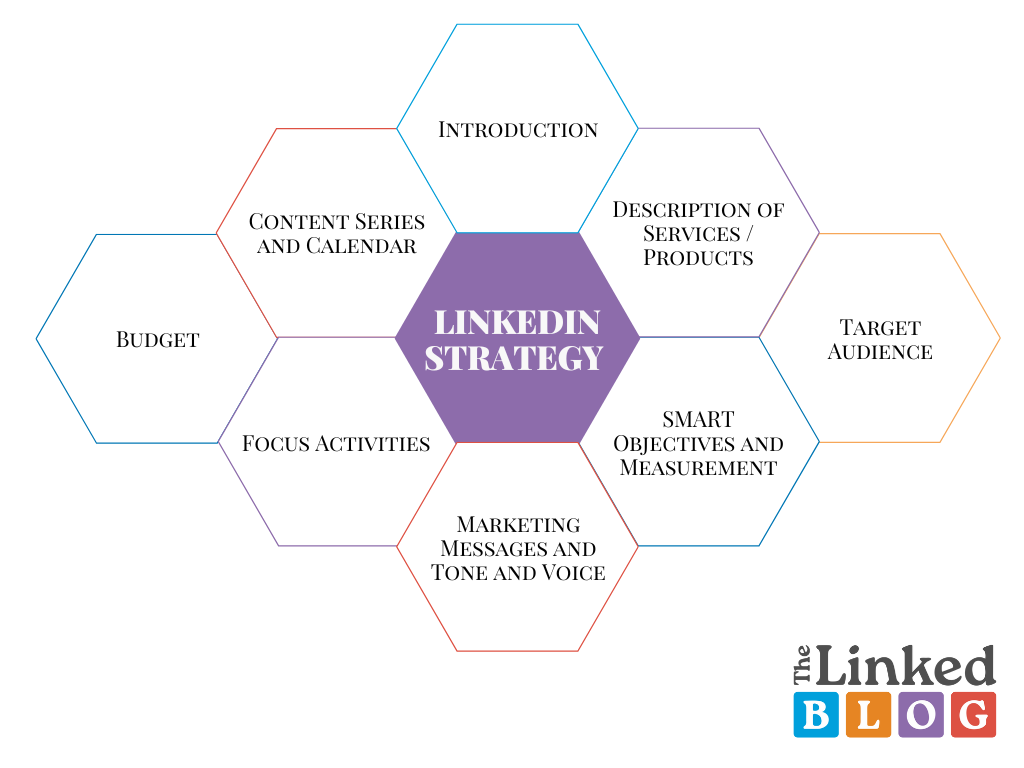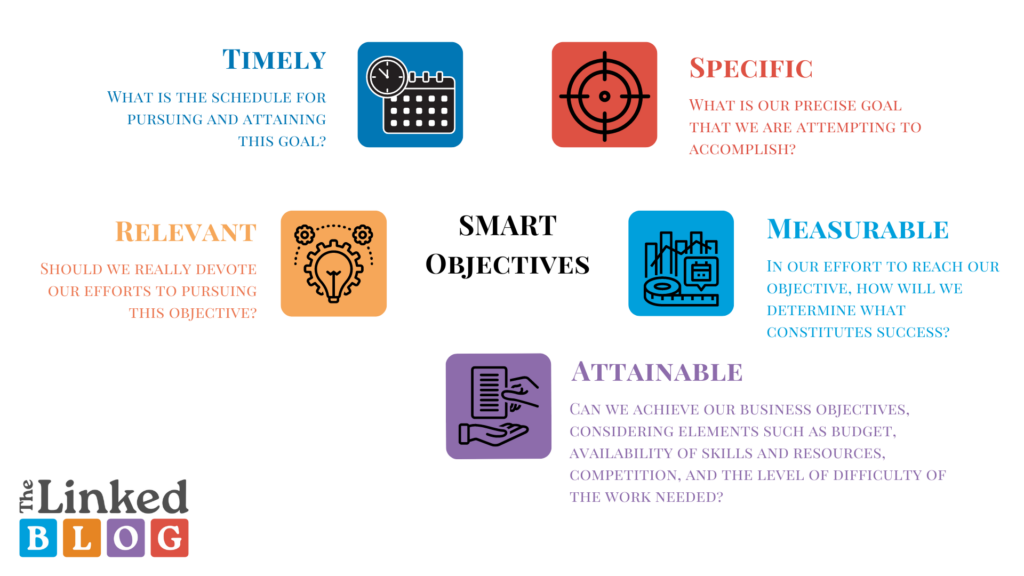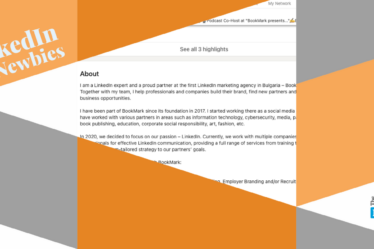
LinkedIn has evolved into a valuable platform for businesses seeking to broaden their reach and engage with their target audience. LinkedIn is an effective tool for increasing brand awareness, establishing thought leadership, and generating leads, with over 900 million users and counting. However, simply being present on the platform is not sufficient. To maximize your company’s potential on LinkedIn, you need a well-crafted LinkedIn strategy that is tailored to your goals, target audience, and the type of content that resonates with them. A solid LinkedIn strategy can help you establish your company as an industry thought leader, increase the visibility, and reach of your brand, and generate new business opportunities. In this article, we’ll look at why having a LinkedIn strategy for your company page is important, as well as how to develop a successful strategy that produces results and examine all parts of the strategy.
Your LinkedIn strategy should include:
- Introduction
- Description of Product / Services
- Target Audience
- SMART Objectives and Measurement
- Marketing Messages and Tone and Voice
- Focus Activities
- Content Series and Calendar
- Budget
It basically follows the classic structure of (B2B) communications strategies, this time with focus on one channel only.
Have in mind that your LinkedIn strategy is an internal document for different readers – the CFO, for example, who would have to approve your ads budget would probably have very little knowledge about the professional network, so the document would help them have some context. In other cases, you may have a new member of the marketing/comms team in the middle of the year so they’d have to follow the Strategy in their work – they would also need some context for the approaches and techniques your company uses on Linkedin.
Now let’s go through each part separately.

Introduction
The introduction of a LinkedIn strategy is a component that outlines the purpose and objectives of the plan. A comprehensive introduction should include an overview of the strategy, identifying the target audience,s and setting clear objectives and key performance indicators. The promotion plan should be explained, outlining how to promote the LinkedIn content through paid advertising, email campaigns, and influencer partnerships. Additionally, the introduction should address how to evaluate the effectiveness of the LinkedIn strategy and make necessary adjustments for continued success over time. By including these key elements, the LinkedIn strategy introduction can provide a clear direction, setting the tone for the rest of the plan and ultimately leading to better results. Keep this part short – again, your readers will need context, but 1 page should be enough.
Description of Product/Services
When describing our product or services, it is essential to provide a clear and concise explanation of the unique selling proposition (USP) that sets us apart from our competitors. It should highlight the benefits and solutions our services or products offer to our target market. By clearly communicating our USP and the value it delivers, we can differentiate ourselves and establish a competitive edge.
It is critical to highlight the specific problems our services or products solve, and the benefits they provide. By doing so, we can connect with our target audience’s pain points and demonstrate how our services or products can help alleviate their concerns.
This approach can help build credibility and trust with our audience, which is essential for building long-term relationships.
Target Audiences
Defining and understanding your target audience is a crucial step in developing a successful LinkedIn strategy. It involves determining the specific characteristics of the group of people you want to reach, such as their age, gender, location, job title, and interests. Once you’ve defined your target audience, you can tailor your content and messaging to appeal to their needs and pain points, which helps drive engagement and build brand awareness.
For example, if you’re targeting HR professionals with your HR consulting services, you can create content that addresses the challenges they face and offers solutions to their problems. If your target audience is interested in technology, you can create content on the latest tech trends and innovations to engage them.
By analyzing your target audience, you gain insights into their interests, motivations, and preferences, which allows you to build stronger relationships and drive better results.
It’s important to understand your target audience’s characteristics, as this can help you craft a message that resonates with them and ultimately drives business success.
Objectives and Measurement
Setting SMART objectives helps you to define your goals clearly, set realistic targets, and track your progress toward achieving them. Specific objectives allow you to identify precisely what you want to accomplish, while measurable objectives make it possible to track your performance accurately. Achievable objectives are realistic and attainable, while relevant objectives ensure that your goals align with your broader business objectives. Time-bound objectives specify the time frame within which you aim to achieve your objectives.

To measure the effectiveness of your LinkedIn strategy, you can track various metrics such as engagement levels, leads generated, brand awareness, and website traffic. By monitoring these metrics, you can determine the success of your strategy, refine your content, and improve your results. Effective measurement of SMART objectives allows you to make data-driven decisions, improve your strategy, and ultimately achieve your business objectives.
Messages and Tone of Voice
Developing a strong tone and voice for your LinkedIn marketing strategy is an essential step in attracting and retaining your target audience. It all starts with defining your brand’s values and persona to project to your audience. Ensuring consistency in messaging is equally important, as it helps establish brand recognition.
When crafting marketing messages, it’s essential to have a clear understanding of your target audience’s needs and challenges to develop messaging that resonates with them.
Your language should be concise, compelling, and tailored to speak directly to your audience while highlighting your unique value proposition. You can also include a clear call-to-action to drive more meaningful interactions with your content. By developing a unique and consistent tone and voice that accurately represents your brand’s mission and values, your LinkedIn marketing strategy will be more effective in engaging your audience and ultimately leading to business growth.
Focus Activities
In this section, you need to define the key activities that your company will have for the duration of your strategy. These activities might be paid/organic campaigns, webinars, live events, or research you will conduct. After clearly defining all focus activities and their timeline, you need to think of the ways you will promote these activities both organically and through paid ads on LinkedIn. To ease your work in the future, you can even create the concept, copywriting, and visuals for each focus activity in advance.
Content Series and Calendar
Developing a content series and a content calendar is essential for creating a successful LinkedIn marketing strategy. Content series is an effective tool to keep your audience engaged and consistently drive traffic to your profile. To create such a series, choose topics that align with your brand, then break them down into smaller subtopics and provide valuable information to your audience. Incorporating different content formats can help keep the series interesting and engaging.
A content calendar is equally important in ensuring that your content is consistent and that your messaging aligns with your marketing goals. Start by identifying significant dates and events that are relevant to your brand or industry, then choose the type of content that will engage your audience. Finally, map out the schedule evenly and align it with your marketing objectives. Consistently providing high-quality content positions your brand as an authority in your industry and helps build meaningful relationships with your audience.
Budget
When creating a budget for your LinkedIn strategy, it’s crucial to first identify your marketing objectives and key performance indicators (KPIs). This ensures that your budget is in line with your objectives. You should consider your target audience, messaging, content creation, and the types of campaigns you plan to run such as sponsored content or sponsored InMail. You should also take into account the cost of creating content, the need for external resources, and any additional tools or services needed to run effective campaigns.
Starting with a smaller budget and measuring campaign performance is one way to optimize your budget. You can then make changes as needed to improve performance.
And here is one of our favorite episodes of AJ Wilcox’s LinkedIn Ads Show podcast, dedicated to the top strategies for advertising on LinkedIn.
It’s important to regularly track and monitor your spending to ensure you are staying within budget and achieving a return on investment. By creating a well-defined budget, you can develop a LinkedIn marketing strategy that is efficient, effective, and delivers a positive return on investment.
To make the most of LinkedIn, a solid strategy is needed. A well-crafted LinkedIn strategy can help establish a brand’s thought leadership, increase its visibility and reach, and generate new business opportunities. To develop a successful strategy, it is essential to create an introduction, describe products/services, identify the target audience, set SMART objectives and measure analysis, craft marketing messages and tone and voice, focus activities, content series, and calendar. By considering each of these elements, a LinkedIn strategy can help create a competitive edge and build long-term relationships, ultimately driving business growth.
The Linked Blog is here to help you or your brand have the best possible LinkedIn presence, so feel free to contact us if you need help!
See what else we can do for you here.



